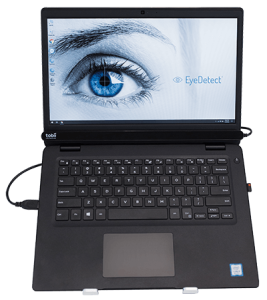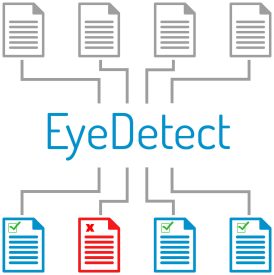Combine EyeDetect with Polygraph to get 97-99% outcome confidence. The two combined are the best lie detector test: highest accuracy.
Best Lie Detector: EyeDetect | 97-99% Accuracy with Polygraph

Polygraph + EyeDetect® = 97-99% Outcome Confidence
A Great Argument For Using Lie Detection Test Results in Court.
In 1955, two scientists (Meehl & Rosen) proposed that if you could test someone with two independent lie detection tests on the same topic — and if that person could pass both tests — then you have greater confidence in the outcome of the two tests when they agree.
That concept was referred to as “successive hurdles” and referred to successive testing. This combination is truly the best lie detector test.
Successive Hurdles
Successive hurdles only works if the two lie detection tests are independent, which means they measure different behaviors. Polygraph measures heart rate, blood pressure, skin conductance, and respiration activity. EyeDetect measures changes in cognitive load which have an involuntary impact on the eyes and reading behavior.
For the first time in the history of lie detection, the successive hurdles model can be reliably used and trusted. Why? Because polygraph and EyeDetect are largely independent and both have high rates of accuracy.

97-99% Outcome Confidence
If someone can pass a polygraph and an EyeDetect test on the same topic, then, as discussed by Meehl & Rosen, based on the statistical model called Bayes Theorem and the published accuracy of those technologies, there can be a 97 to 99% outcome confidence. That is a better outcome than the best lie detector test.
The successive hurdles argument has never been used with polygraph alone because it does not apply to using two successive polygraph tests.
However, with the advent of EyeDetect, and given that EyeDetect and polygraph have been shown in scientific lab studies to have greater than 85% accuracy, the statistical model based on Bayes Theorem now has applicability.
In conclusion, based on science and proven statistical models, we believe there’s now a valid argument to allow lie detector test results in a court of law.
To see how, read the AAPP Journal article here.
“Using EyeDetect and polygraph in a successive hurdles model is the
-Mark Handler-
Use EyeDetect and Polygraph for Screening
In the typical hiring process, applicants must pass through multiple tests (or hurdles).
These include:
- Job application
- Initial interview
- Physical agility test
- Psych evaluation
- Written test
- Criminal background check
- Reference check
- Credibility assessment (lie detection)
- Medical screening

In most hiring processes, if an applicant fails one test, that person is disqualified. Consider the time, effort and expense of conducting these hurdles. In the best model, each hurdle is progressively more time-consuming, more expensive and more intrusive.
When to use EyeDetect?
Applying an EyeDetect test at the beginning of the process would not only be one of the least expensive steps, it would filter out the “bad” applicants who will probably not pass the other tests.
If you focus on the most credible applicants, it will improve the quality of the entire applicant pool. Then, applying a polygraph exam to those who have made it through the entire process can give you 97 to 99% outcome confidence that you have hired the right person. Without a doubt, that combination is “the” best lie detector test.
Former CIA polygraph examiner discusses
using EyeDetect with polygraph. (3:42)


Converus (“with truth”) provides scientifically validated credibility assessment technologies that help protect countries, corporations and communities from corruption, crime and threats.

